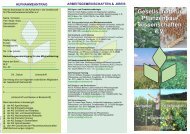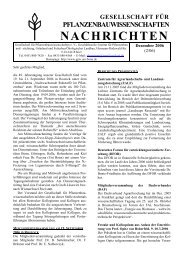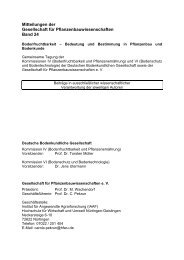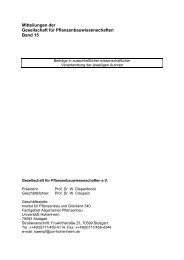Mitteilungen der Gesellschaft für Pflanzenbauwissenschaften Band 23
Mitteilungen der Gesellschaft für Pflanzenbauwissenschaften Band 23
Mitteilungen der Gesellschaft für Pflanzenbauwissenschaften Band 23
Erfolgreiche ePaper selbst erstellen
Machen Sie aus Ihren PDF Publikationen ein blätterbares Flipbook mit unserer einzigartigen Google optimierten e-Paper Software.
Mitt. Ges. Pflanzenbauwiss. <strong>23</strong>: 142–143 (2011)<br />
Influence of N fertilization and genotype<br />
on N retranslocation during reproductive growth in oilseed rape<br />
Abdullah Ulas 1 , Torsten Behrens 1 , Franz Wiesler 2 , Walter J. Horst 1 and<br />
Gunda Schulte auf`m Erley 1<br />
1<br />
Institute for Plant Nutrition, Leibniz University of Hannover;<br />
schulteaufmerley@pflern.uni-hannover.de<br />
2 LUFA, Speyer. E-Mail:<br />
Introduction<br />
Oilseed rape is one of the crops with the highest N balance surpluses in European<br />
agriculture. The high surpluses are mainly caused by two processes, a low N<br />
recovery from the soil and an incomplete N retranslocation from the vegetative<br />
biomass into the seeds. Genotypic variation in N uptake was found, which was<br />
related to yield at limiting and high N supply (Schulte auf’m Erley et al., 2011). The<br />
incomplete N retranslocation from vegetative plant parts has mostly been ascribed to<br />
insufficient leaf N retranslocation prior to leaf fall. N recoveries from leaves have<br />
been studied in detail for oilseed rape (Malagoli et al., 2005; Gombert et al. 2010),<br />
but no reports on genotypic variation in this trait are available yet.<br />
Materials and Methods<br />
Four winter oilseed rape cultivars differing in N efficiency were grown at three N rates<br />
in a three-year field experiment performed south of Göttingen. Harvests were<br />
performed at the beginning of flowering and at maturity. Plants were fractionated into<br />
stems, leaves, pod walls and seeds. In addition, dead leaves were collected weekly<br />
between beginning of flowering and maturity from mesh nets placed into the plots.<br />
Dry weights and N contents of all plant fractions were determined.<br />
Results and Discussion<br />
Cultivars differed in seed yield at all N rates (Table 1). Cultivar Apex could be<br />
characterized as N-efficient due to its highest yield at low N, while cv Bristol was<br />
superior in seed yield at high N supply. The high N efficiency of cv Apex was related<br />
to a high N uptake, while the superior yield of cv Bristol at high N was only partly due<br />
to superior N uptake.<br />
Table 1: Seed yield and N uptake of four winter oilseed rape cultivars grown at three<br />
N rates (N0: soil Nmin; N120: 120 kg N ha -1 ); N 240: 240 kg N ha -1 ) in a three-year<br />
field experiment.<br />
Seed yield (t ha -1 ) N uptake (kg ha -1 )<br />
Cultivar N0 N120 N240 N0 N120 N240<br />
Apex 3,02 b 4,26 b 4,63 a 85,3 b 142,8 b 198,5 b<br />
Bristol 2,70 a 4,26 b 4,99 b 73,3 a 129,4 a 193,1 b<br />
Lirajet 2,69 a 3,88 a 4,57 a 75,2 ab 1<strong>23</strong>,4 a 188,9 b<br />
Capitol 2,67 a 3,94 a 4,46 a 74,9 a 122,3 a 171,7 a<br />
F-Test: C:*** N:*** CxN:* C:*** N:*** CxN:*







